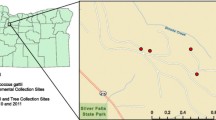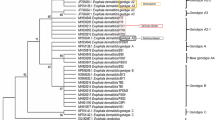Abstract
Cryptococcus neoformans var. grubii and C. gattii were repeatedly isolated from decaying wood of trunk hollows in living trees growing in Jabalpur City in Central India. The isolation of C.␣gattii has been reported from decayed wood inside trunk hollow of Tamarindus indica (15.6%), Mangifera indica (2.2%), Pithecolobium dulce (12.5%), Syzygium cumini (14%), and one from bark of S.␣cumini. C. n. var. grubii was isolated from decaying wood debris of T. indica (4.4%), M. indica (13.3%), Terminalia arjuna (25%), S. cumini (2%), Cassia fistula (4.5%), and two from bark of S. cumini. The two varieties never co-occurred in the same hollow. C. gattii and C. n. var. grubii isolates belonged to serotype B and serotype A respectively. The data strongly supported the colonization of the pathogen in␣decaying wood hollow of all six-tree species. Evidence of this was found by repeated isolation up to 820 days. P. dulce is being reported for the first time as natural habitat of C. gattii and T.␣arjuna and C. fistula as natural habitat for C. n. var. grubii. M. indica is being reported for the second time as the natural habitat of both varieties (C. n. var. grubii and C. gattii). The population density of these pathogens from decaying wood debris of various tree species ranged between 0.5 × 103 cells/g and 6 × 105 cells/g. The seasonal variation has been seen in isolation of this yeast. Our result further reinforce the recently emerging evidence that the natural habitat of C. n. var. grubii and C. gattii is more generalized.
Similar content being viewed by others
References
Casadevall A, Perfect JR. Cryptococcus neoformans. 1st␣edn. Washington, DC: ASM Press, 1998.
Mitchell TG, Perfect JR. Cryptococcosis in the era of AIDS—100 years after the discovery of Cryptococcus neoformans. Clin Microbiol Rev 1995;8:515–48.
Franzot SP, Salkin IF, Casadevall A. Cryptococcus neoformans var. grubii: separate varietal status for Cryptococcus neoformans serotype A isolates. J Clin Microbiol 1999;37:838–40.
Kwon-Chung KJ, Boekhout T, Fell JW, Daiz M. Proposal to conserve the name Cryptococcus gattii against C.␣hondurianus and C. bacillisporus (Basidiomycota, Hymenomycetes, Tremellomycetidae) Taxon 2002;51:804–6.
Misra VC, Randhawa HS. Occurrence and significance of Cryptococcus neoformans in vegetables and fruits. Indian J Chest Dis Allied Sci 2000;42:317–21.
Randhawa HS, Kowshik T, Khan ZU. Decayed wood of Syzygium cumini and Ficus religiosa living trees in Delhi/New Delhi metropolitan area as natural habitat of Cryptococcus neoformans. Med Mycol 2003;41:199–209.
Kwon-Chung KJ, Bennett JE. Cryptococcus and Cryptococcosis. In: Kwon-Chung KJ, Bennett JE, editors. Medical mycology. Philadelphia: Lea and Febiger; 1992. p.␣397–446.
Lazéra MS, Wanke B, Nishikawa MM. Isolation of both varieties of Cryptococcus neoformans from saprophytic sources in the city of Rio de Janeiro, Brazil. J Med Vet Mycol 1993;31:449–54.
Kwon-Chung KJ, Bennett JE. High prevalence of Cryptococcus neoformans var. gattii in tropical and subtropical regions. Zbl Bakt Hyg 1984;257:213–8.
Staib F, Thielke C, Randhawa HS, Senska M, Kulins G. Colonisation of dead plants by Cryptococcus neoformans. Zbl Bakt Hyg 1972;222:407–14.
Bauwens L, Swinne D, Vroey De C, Meurichy W. Isolation of Cryptococcus neoformans var. neoformans in the aviaries of the Antwerp zoological gardens. Mykosen 1986;29:291–4.
Ellis DH, Pfeiffer TJ. Natural habitat of Cryptococcus neoformans var. gattii. J Clin Microbiol 1990;28:1642–4.
Fortes ST, Lazera MS, Nishikawa MM, Macedo RCL, Wanke B. First isolation of Cryptococcus neoformans var. gattii from a native jungle tree in the Brazilian Amazon rainforest. Mycoses 2001;44:137–40.
Kidd SE, Hagen F, Tscharke RL, Huynh M, Bartlett KH, Fyfe M, et al. A rare genotype of Cryptococcus gattii caused the cryptococcosis outbreak on Vancouver Island (British Columbia, Canada). Proc Nat Acad Sci USA. 2004;101:17258–63.
Krockenberger MB, Canfield PJ, Malik R. Cryptococcus neoformans in the Koala (Phascolarctos cinereus): colonisation by C. n. var. gattii and investigation of environmental sources. Med Mycol 2002;40:263–72.
Lazéra MS, Cavalcanti MAS, Londero AT, Trilles L, Nishikawa MM, Wanke B. Possible primary ecological niche of Cryptococcus neoformans. Med Mycol 2000;38:379–83.
Lazéra MS, Cavalcanti MAS, Trilles L, Nishikawa MM, Wanke B. Cryptococcus neoformans var. gattii—evidence for a natural habitat related to decaying wood in a pottery tree hollow. Med Mycol 1998;36:119–22.
Lazéra MS, Pires FDA, Camilo-Coura L, Nishikawa MM, Bezerra CCF, Trilles L, Wanke B. Natural habitat of Cryptococcus neoformans var. neoformans in decaying wood forming hollows in living trees. J Med Vet Mycol 1996;34:127–31.
Nawange SR, Shakya K, Naidu J, Singh SM, Jharia N, Garg S. Decayed wood inside trunk hollows of living trees of T. indica, S. cumini and M. indica as natural habitat of Cryptococcus neoforman and their serotypes in Jabalpur city of Central India. J Mycol Med 2006:63–71.
Nishikawa MM, Lazera MS, Barbosa GG, Trilles L, Balassiano BR, Macedo RCL, et al. Seroty** of 467 Cryptococcus neoformans isolates from clinical and environmental sources in Brazil: analysis of host and regional patterns. J Clin Microbiol 2003;41:73–7.
Pfeiffer TJ, Ellis DH. Environmental isolation of Cryptococcus neoformans var. gattii from California. J Infect Dis 1991;163:929–30.
Pfeiffer TJ, Ellis DH. Environmental isolation of Cryptococcus neoformans var. gattii from Eucalyptus tereticornis J Med Vet Mycol 1992;30:407–8.
Randhawa HS, Mussa AY, Khan ZU. Decaying wood in trunk hollows as a natural substrate for Cryptococcus neoformans and other yeast-like fungi of clinical interest. Mycopathologia 2000;151:63–9.
Restrepo A, Baumgardner DJ, Bagagli E, Cooper Jr CR, McGinnis Mr, Lazera MS. Clues to the presence of pathogenic fungi in certain environment. Med Mycol 2000;38(1):67–77.
Vilcins I, Krockenberger M, Agus H, Carter DA. Environmental sampling for Cryptococcus neoformans var. gattii from the Blue Mountains National Park, Sydney, Australia. Med Mycol 2002;40:53–60.
Staib F. Cryptococcus neoformans und Guizotia abyssinica (Syn. G. oleifera D.C.). Z Hyg 1962;148:466–75.
Kwon-Chung KJ, Polacheck I, Bennett JE. Improved diagnostic medium for separation of Cryptococcus neoformans var. neoformans (serotypes A and D) and Cryptococcus neoformans var. gattii (serotypes B and C). J␣Clin Microbiol 1982;15:535–7.
Ikeda R, Shinoda T, Fukazawa Y, Kaufman L. Antigenic characterization of Cryptococcus neoformans serotypes and its application to seroty** of clinical isolates. J Clin Microbiol 1982;16:22–9.
Callejas A, Ordonez N, Rodriguez MC, Castaneda E. First isolation of Cryptococcus neoformans var. gattii, serotype C, from the environment in Colombia. Med Mycol 1998;36:341–4.
Granados DP, Castaneda E. Isolation and characterization of Cryptococcus neoformans varieties recovered from natural sources in Bogota, Colombia, and study of ecological conditions in the area. Microb Ecol 2005;49:282–90.
Gugnani HC, Mitchell TG, Litvintseva AP, Lengelu KB, Heitman J, Kumar A, et al. Isolation of Cryptococcus gattii and Cryptococcus neoformans var. grubii from the flowers and bark of Eucalyptus trees in India. Med Mycol 2005;43:565–9.
Williamson PR. Biochemical and molecular characterization of diphenol oxidase of Cryptococcus neoformans: identification as a laccase. J Bacteriol 1994;176: 656–64.
Dhindsa MK, Grewal PK, Singh SM. Natural occurrence of Cryptococcus neoformans var. neoformas in soil contaminated with pigeon excreta at Jabalpur M.P. Vislesana (Res.␣J. Sci.) R.D. Univ. 1994;1(2):139–43.
Singh SM, Naidu J, Sharma A, Nawange SR, Singh K. First case of cryptococcosis in a new species of bandicoot (Bandicota indica) caused by Cryptococcus neoformans var. grubii. Med Mycol 2007;45:89–93.
Acknowledgements
The authors wish to thank the Vice Chancellor R. D. University and for providing laboratory facilities and to Professor Rani Shukla, Government M. H. College of Home Science and Science Jabalpur for identifying the tree Species. We also thank Mr. Arvind Kavishwar of Indian Council of Medical Research (ICMR), Jabalpur for statistical analysis of data and Dr. A. P. Upadhaya of Meterological Department of Agricultural College, Jabalpur for providing the meteorological data. The Director General, Indian Council of Medical Research (ICMR), New Delhi for awarding Senior Research Fellowship and Research Associateship and Government of India, Ministry of Science and Technology, Department of Sciences and Technology SERC FAST Track Scheme for Young Scientist to one of the author (SRN).
Author information
Authors and Affiliations
Corresponding author
Additional information
An erratum to this article is available at http://dx.doi.org/10.1007/s11046-009-9203-y.
Rights and permissions
About this article
Cite this article
Grover, N., Nawange, S.R., Naidu, J. et al. Ecological niche of Cryptococcus neoformans var. grubii and Cryptococcus gattii in decaying wood of trunk hollows of living trees in Jabalpur City of Central India. Mycopathologia 164, 159–170 (2007). https://doi.org/10.1007/s11046-007-9039-2
Received:
Accepted:
Published:
Issue Date:
DOI: https://doi.org/10.1007/s11046-007-9039-2




